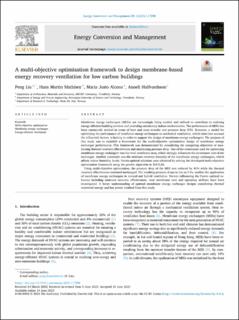| dc.contributor.author | Liu, Peng | |
| dc.contributor.author | Mathisen, Hans Martin | |
| dc.contributor.author | Justo Alonso, Maria | |
| dc.contributor.author | Halfvardsson, Anneli | |
| dc.date.accessioned | 2023-06-16T05:06:31Z | |
| dc.date.available | 2023-06-16T05:06:31Z | |
| dc.date.created | 2023-06-13T11:29:52Z | |
| dc.date.issued | 2023 | |
| dc.identifier.issn | 0196-8904 | |
| dc.identifier.uri | https://hdl.handle.net/11250/3071687 | |
| dc.description.abstract | Membrane energy exchangers (MEEs) are increasingly being studied and utilized to contribute to realising energy-efficient building services and providing satisfactory indoor environments. The performance of MEEs has been extensively studied in terms of heat and mass transfer and pressure drop (PD). However, a model for optimizing the performance of membrane energy exchangers in residential ventilation, which takes into account the influential factors, is lacking in order to support the design of membrane energy exchangers. The purpose of this study was to establish a framework for the multi-objective optimisation design of membrane energy exchanger performance. This framework was demonstrated by considering the competing objectives of maximising thermal recovery effectiveness and minimising pressure drop. One of the constraints used for optimising membrane energy exchangers was the total membrane area, which strongly influences the investment cost of the exchanger. Another constraint was the moisture recovery intensity of the membrane energy exchangers, which affects indoor humidity levels. Pareto optimal solutions were obtained by solving the developed multi-objective optimisation framework using the genetic algorithm in MATLAB.
Using multi-objective optimisation, the pressure drop of the MEE was reduced by 41% while the thermal recovery effectiveness remained unchanged. The resulting pressure drops as low as 5 Pa, enables the application of membrane energy exchangers in natural and hybrid ventilation. Factors influencing the Pareto optimal solutions including moisture recovery effectiveness, total membrane area and operating airflows have been investigated. A better understanding of optimal membrane energy exchanger designs considering thermal recovered energy and fan power resulted from this study. | en_US |
| dc.language.iso | eng | en_US |
| dc.publisher | Elsevier | en_US |
| dc.rights | CC BY 4.0 | * |
| dc.rights.uri | http://creativecommons.org/licenses/by/4.0/deed.no | * |
| dc.subject | Multi-objective optimisation | en_US |
| dc.subject | Membrane energy exchanger | en_US |
| dc.subject | Energy-efficient ventilation | en_US |
| dc.title | A multi-objective optimisation framework to design membrane-based energy recovery ventilation for low carbon buildings | en_US |
| dc.title.alternative | A multi-objective optimisation framework to design membrane-based energy recovery ventilation for low carbon buildings | en_US |
| dc.type | Peer reviewed | en_US |
| dc.type | Journal article | en_US |
| dc.description.version | publishedVersion | en_US |
| dc.rights.holder | © 2023 The authors | en_US |
| dc.subject.nsi | VDP::Teknologi: 500 | en_US |
| dc.source.volume | 291 | en_US |
| dc.source.journal | Energy Conversion and Management | en_US |
| dc.identifier.doi | 10.1016/j.enconman.2023.117298 | |
| dc.identifier.cristin | 2154050 | |
| dc.relation.project | Norges forskningsråd: 296489 | en_US |
| dc.source.articlenumber | 117298 | en_US |
| cristin.ispublished | true | |
| cristin.fulltext | original | |
| cristin.qualitycode | 1 | |

